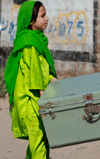Taliban militants killed four schoolchildren in a remote town in Pakistan’s northwestern tribal belt on Tuesday. Local officials say the attack has sectarian dimensions as militants – who hail from the majority Sunni sect – targeted students of the minority Shi’a sect. Previously, the Taliban have singled out minority sects as part of their strategy in Pakistan.

|
|
A girl and her father carry their belongings to a bus station while fleeing Pakistan’s northwest Khyber Agency on September 10, 2009, days after security forces launched an offensive against militants in the area. REUTERS/Fayaz Aziz |
The students were going to school in Atmankhel town of Orakzai district when the militants opened fire, killing four boys and wounding six others, local administration official Asmatullah Khan told AFP.
“It appears to be a sectarian attack as the slain students belonged to the minority Shi’a sect of Islam,” he said. “The attackers were Taliban.”
Residents said the dead students were all younger than 16, but were not able to give the exact ages of the victims.
Eyewitnesses report that tribesmen from Atmankhel retaliated after the attack on the school children, killing two militants and leaving several wounded, reports Dawn, an English-language Pakistani daily.
The Pakistani Taliban have attacked schools in Pakistan’s northwest since 2007, the Inter Press Service reported in January. According to the Associated Press, more than 170 schools were blown up or burned down by January as part of the militant campaign. These attacks did not, however, result in casualties, as the militants usually struck the schools when they were closed.
The Taliban have targeted members of the minority Shi’a sect before. In 2008, the Taliban besieged Parachinar, a Shi’a enclave in Pakistan’s tribal belt, reported The New York Times.
The Taliban, which have solidified control across Pakistan’s tribal zone and are seeking new staging grounds to attack American soldiers in Afghanistan, have sided with fellow Sunni Muslims against an enclave of Shi’a settled in Parachinar for centuries.
Writing in Newsday, James Rupert explained that the Afghan Taliban also targeted the Shi’a minority in Afghanistan.
“In the five years of Taliban rule over most of Afghanistan, the bitterest warfare and deadliest atrocities were those between the Taliban, drawn mainly from Afghanistan’s dominant Pashtuns, and the minority Hazaras, set apart from other Afghans as followers of the Shi’a branch of Islam and historically the most downtrodden of the country’s ethnic groups….
“The brutality of the Hazara-Taliban conflict has been rooted partly in the special antipathy that the Sunni Muslim Taliban and their Arab allies have for Muslims of the Shi’a sect…. ‘They do not regard us (Shi’a) as people,'” said Ahmed Hussain, another Bedmushkin resident.
In recent months, the Taliban have also set their sights on members of Pakistan’s Sufi sect. In March, CBC News reported that the Taliban bombed the mausoleum of Sufi poet Rahman Baba on the outskirts of Peshawar, and the caretakers of Sufi shrines in Pakistan’s southern Sindh Province have also been attacked.
The killing of the schoolchildren in Pakistan comes as the military is engaged in a fresh offensive against Taliban militants in Khyber Agency, a neighboring tribal region. According to the South Asian News Agency, more than 57 militants have been killed and 107 arrested by the Pakistan Army in the past week.






Leave a Reply